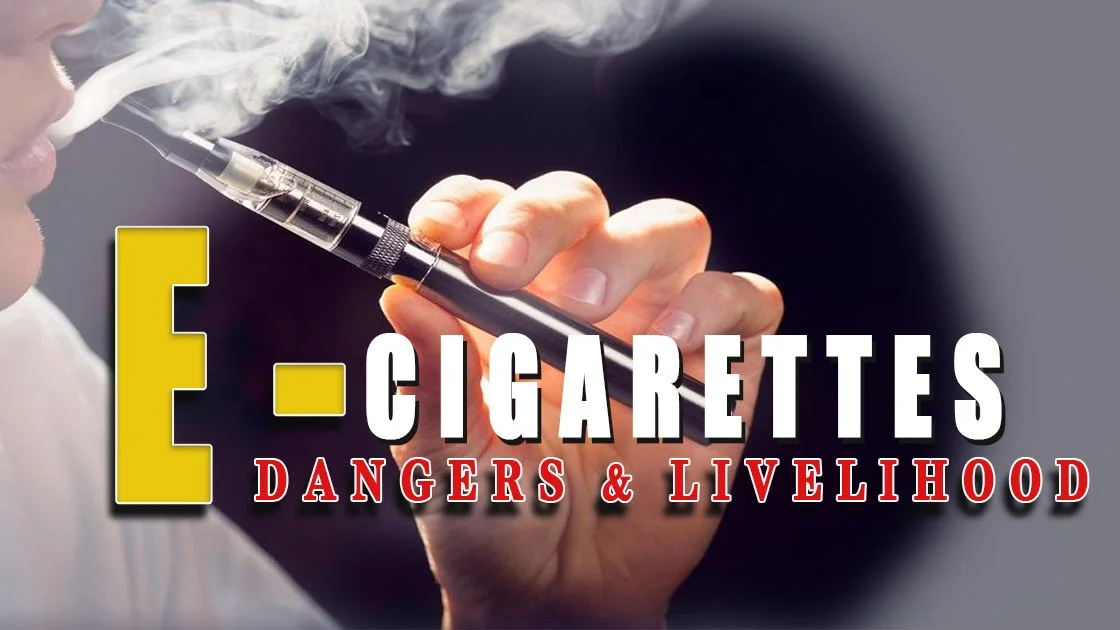What is e- Cigarette?
Electronic Nicotine Delivery Systems (ENDS) or non-combustible tobacco products are known by many names — vapes, e-hookahs, electronic cigarettes and e-pipes. An e-cigarette, which is a battery-operated device, produces aerosol by heating a solution containing nicotine among other things. The device contains nicotine and flavours in the form of liquid which is primarily composed of solvents such as glycerol and/or propylene glycol. The aerosol containing a suspension of fine particles and gases simulates cigarette smoke. Following a puff, the aerosol is delivered to the user’s mouth and lungs and the rest is exhaled.
Associated health risk of e- cigarettes
A 2018 study found the use of e-cigarette daily was associated with a 79% increase in heart attack risk after other variables were taken into account. According to a white paper on e-cigarettes by the Indian Council of Medical Research (ICMR), depending on the battery output voltage used, nicotine solvents can release in varying amounts potential carcinogens such as acetaldehyde, formaldehyde and acetone. Flavours such as diacetyl used in e-cigarettes are linked to serious lung disease. Nicotine “harms parts of the brain that control attention, learning, mood, and impulse control.” Nicotine also changes the way synapses — connections between brain cells — are formed. This is of concern as more synapses are formed in younger brains.
Flavours in e-cigarettes have been cited as one of the top three reasons for children to use them. The misconception that “e-cigarettes are less harmful than other forms of tobacco such as cigarettes” is another main reason. Youth who use e-cigarettes may be more likely to go on to smoke conventional cigarettes.
Are youngsters ill-informed about the harmful effects of vapouring?
Firms citing that e- cigarettes are not harmful and is a cessation device, causes several youngsters to get hooked to it. Moreover e-cigarettes may be manufactured to look like traditional cigarettes and are marketed as tobacco-free nicotine delivery devices which seems too attractive to youngsters.
In 2016, the U.S. Surgeon General had concluded that “e-cigarette use among youths and young adults is a public health concern; exposure to nicotine during adolescence can cause addiction and can harm the developing adolescent brain.”
Is Ban on E- cigarettes a sudden decision or a planned one?
In 2018, an advisory containing the cessation on the use of nicotine in any food item in India was passed from the Centre to all States. Therefore, nicotine was already banned. The quantities of nicotine permitted is defined under Drugs and Cosmetics Act. Under the Act, only 2-4 mgs of nicotine can be used in nicotine chewing gum, nicotine lozenge, transdermal patch, nicotine inhaler, nicotine nasal spray, and nicotine sublingual tablets as nicotine replacement therapies. All is not approved in India as nicotine replacement therapies but they were anyways sold in India illegally. States were banning this product under Drugs and Cosmetics Act. Ban on nicotine products by States was challenged in the court of law. The government of India in its wisdom decided to bring an ordinance because this is the urgent public health issue. Youngsters visit hookah bar almost everyday in India. Each one of us in our family has a member who are hooked to vapouring. They inhale ENDS thinking that it is not harmful. Therefore, there was the need to tell them that what they are inhaling is not a vapour but a battery power device which contains carcinogenic material and are directly going into our blood streams.
Why Tobacco and chew gums are not banned?
Chew gums are approved as a cessation tool. Cigarettes and other tobacco products ( COTPA) ACT necessities 85% of the cover of the cigarettes for advisement against the use of cigarettes. Global Adult Tobacco ( GAT) survey finds that such advertisement reduces smoking by 6%. Also, according to the GAT survey 10.6% of the population smoke traditional cigarettes. This means that 95% of the population do not smoke tobacco cigarettes but smoke e- cigarettes which are mainly youngsters. Ban on tobacco farming would hit many livelihoods which are dependent on it.
In China, retailers stopped selling a particular brand of e- cigarettes which was most popular among people.
Effects on livelihoods dependent on tobacco farming and marketing.
India is one of the largest producers of tobacco. India also contribute in exports of tobacco.
Tobacco Board of India in Guntur, Andhra Pradesh is promoting the production of tobacco as well as ensuring farmers get a remunerative price. Some measures were taken to promote tobacco farming and marketing:-
1.No permission was given to foreign firms to produce in India or to any foreign brands to sell tobacco related products in India. Yet foreign companies had made their place in India illegally along Eastern and Northern borders. Volume of illegal producers are so high that it bothers producers who are licensed.
Way forward:
Health is the foremost concern of a welfare State. Therefore, India has banned the use of e- cigarettes concerning the health of the people, especially the youngsters.
It is also important for a welfare State to take care of the livelihood of the people. Therefore, necessary mechanism must be adopted to remove illegal foreign producers of tobacco related products from the market. Also, it is equally important to create alternative sources of livelihood for tobacco farmers and producers before banning its use suddenly.
